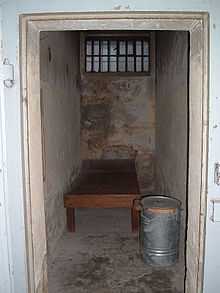Berlin-Hohenschönhausen Memorial
Coordinates: 52°32′30.3″N 13°30′5.4″E / 52.541750°N 13.501500°E

The Berlin-Hohenschönhausen Memorial (German: Gedenkstätte Berlin-Hohenschönhausen) is a museum and memorial located in Berlin's north-eastern Lichtenberg district in the locality of Alt-Hohenschönhausen, part of the former borough of Hohenschönhausen. It was opened in 1994 on the site of the main prison of the former East German Communist Ministry of State Security, the Stasi.
Unlike many other government and military institutions in East Germany, Hohenschönhausen prison was not stormed by demonstrators after the fall of the Berlin Wall, allowing prison authorities to destroy evidence of the prison's functions and history. Because of this, today's knowledge of the functioning of the prison comes mainly from eye-witness accounts and documents sourced from other East German institutions.
The prison was depicted in the 2006 film The Lives of Others.
The museum is a member organisation of the Platform of European Memory and Conscience.[1]
History
Pre-World War II
The Hohenschönhausen area was largely industrial prior to World War II. The area later occupied by the main prison building housed a factory manufacturing supplies for the soup kitchens of the National Socialist People's Welfare organization. That red-brick building was completed in 1939.[2]
Special Camp No. 3
In June 1945, at the conclusion of World War II, the Soviet Secret Police took over the Hohenschönhausen area of Lichtenberg and transformed it into a detainment and transit camp, called Special Camp No. 3. The camp served as both a prison and transfer point. Over 20,000 people passed through Special Camp No. 3 on their way to other Soviet camps, including one at the former Nazi concentration camp at Sachsenhausen [3]
Living conditions in the camp were deplorable, with death from malnutrition, disease, or cold common. Although official statistics list 886 deaths at the camp between July 1945 and October 1946, independent estimates put the toll as high as 3,000. Bodies were disposed of in local bomb craters.[2]
The camp was closed and prisoners relocated other camps in October 1946.[2] After the closing of Special Camp No. 3, the Hohenschönhausen compound served as a Soviet prison during the winter of 1946-1947. The former cafeteria was converted to the underground prison area ("submarine") by prison labor.[4]
Stasi Prison
The prison was reopened by the East German Ministry of State Security (MfS), also known as the Stasi, in 1951.[3] The Stasi added a new prison building (using prisoner labor) in the late 1950s. The new building included 200 prison cells and interrogation rooms. After the construction of the Berlin Wall in 1961, the prison was primarily used to house those who wished or attempted to leave the GDR, although political prisoners were also held there. The prison was used until Die Wende in 1989 and officially closed on October 3, 1990.[5]
The main prison also included a hospital wing, built in the 1950s and expanded in 1972. The hospital treated prisoners from all three Berlin prisons and sometimes from regional Stasi prisons as well. The hospital had up to 28 beds (in cells), an x-ray ward, treatment and operating rooms, a laboratory, a morgue, and outdoor exercise cells (called "tiger cages" by prisoners). In 1989, shortly before its closure, the hospital was run by Dr. Herbert Vogel with 28 full-time MfS staff.[6]
Political oppression
Hohenschönhausen was a very important part of the GDR's system of political and artistic oppression.
Although torture and physical violence were commonly employed at Hohenschönhausen (especially in the 1950s),[5] psychological intimidation was the main method of political repression[5] and techniques including sleep deprivation, total isolation, threats to friends and family members, and the use of water cells.
A suggested reason why the torture of East Germany's own citizenry was permitted for so long was Hohenschönhausen exclusion zone. The prison was located in a large restricted area bordered by a large military town. Additionally, it officially did not exist during many of the years it operated, being left off all maps. These two measures combined meant that few people who did not work there know what occurred inside. Because it was not well known, the prison was not stormed by demonstrators after the fall of the Wall. This allowed prison authorities to destroy much of the evidence of their crimes. Today, much of our knowledge comes from former prisoners personal accounts and documentation from other GDR institutions.[7]
Memorial
The Hohenschönhausen Memorial (Gedenkstätte) was founded in the early 1990s by former inmates.[8] The prison was listed as a historical site in 1992 and welcomed its first visitors in 1994. The Foundation is funded equally by both the German federal government and the Berlin state government.[8]
The Foundation was initially headed by Dr. Gabriele Camphausen, then by Mechthild Günther, who served as provisional director until September 2000. Dr. Hubertus Knabe has since served as Executive Director.[8]
The Foundation is open year-round, with hourly tours between 11:00 and 15:00 (10:00 - 16:00 weekends). English-speaking tours are done once-daily at 14:30. Visitors may tour in groups only, entrance fees range from 1 Euro (students) to 5 Euros (regular admission).
Photos
-

Prison transport
-

"U-Boot" Cell door
-
-
-

Berlin-Hohenschönhausen Memorial
-

Prison cell
References
- ↑ "Czech Prime minister Petr Nečas: The years of totalitarianism were years of struggle for liberty". Platform of European Memory and Conscience. 14 October 2011. Retrieved 14 October 2011.
- ↑ 2.0 2.1 2.2 Gedenkstätte Berlin-Hohenschönhausen. "Special Camp 3". Retrieved 9 August 2011.
- ↑ 3.0 3.1 Gedenkstätte Berlin-Hohenschönhausen. "Historial Location". Retrieved 9 August 2011.
- ↑ Gedenkstätte Berlin-Hohenschönhausen. "Soviet Prison". Retrieved 9 August 2011.
- ↑ 5.0 5.1 5.2 Gedenkstätte Berlin-Hohenschönhausen. "The Ministry of State Security (MfS) Remand Prison". Retrieved 9 August 2011.
- ↑ Gedenkstätte Berlin-Hohenschönhausen. "Ministry of State Security (MfS) prison hospital". Retrieved 9 August 2011.
- ↑ History of Hohenschönhausen Prison AwayPlan
- ↑ 8.0 8.1 8.2 Gedenkstätte Berlin-Hohenschönhausen. "Foundation History". Retrieved 9 August 2011.
External links
![]() Media related to Gedenkstätte Berlin-Hohenschönhausen at Wikimedia Commons
Media related to Gedenkstätte Berlin-Hohenschönhausen at Wikimedia Commons

